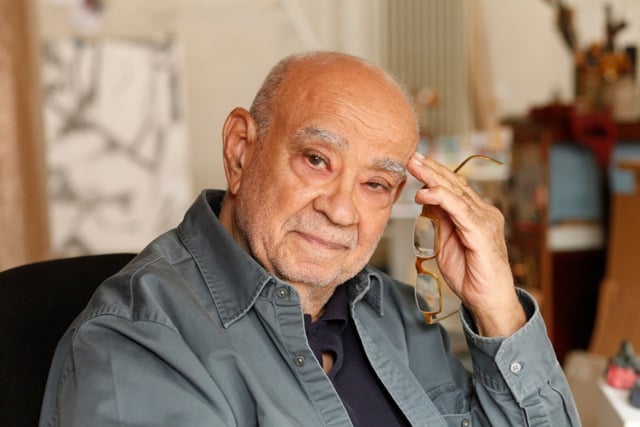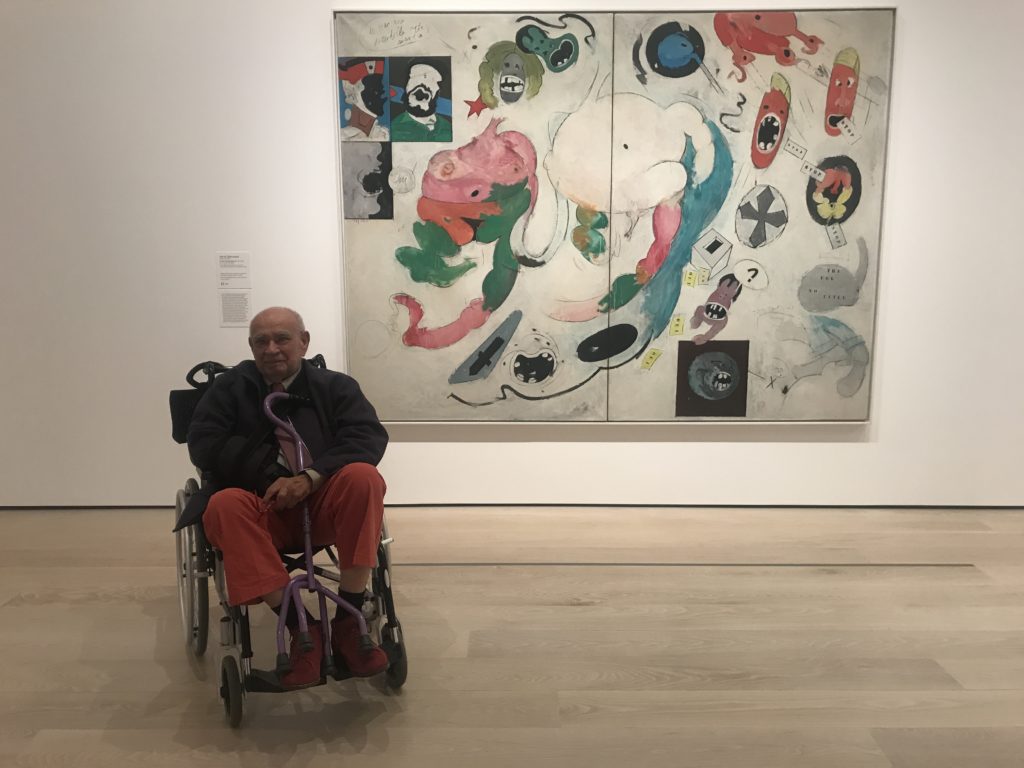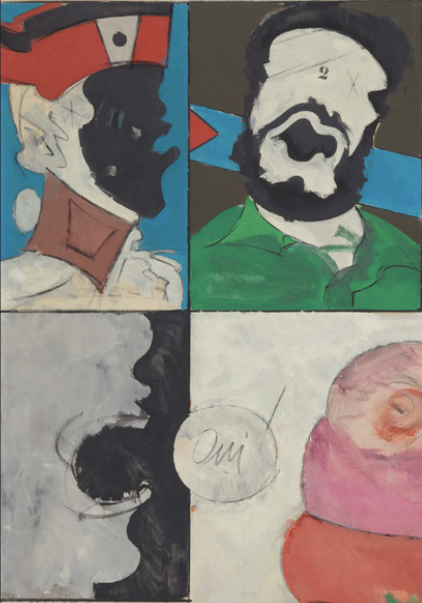People
Artist Hervé Télémaque, 81, Is One of the Previously Overlooked Stars of MoMA’s Rehang. Here’s What He Thinks About It
We caught up with the artist while he was in town for the museum's opening celebrations.

We caught up with the artist while he was in town for the museum's opening celebrations.

Katie White

In the eyes of the 81-year-old Haitian-French artist Hervé Télémaque, the inclusion of his painting, No Title (The Ugly American) (1962/64), in MoMA’s head-to-toe collection rehang feels like a homecoming in once sense, and poetic justice in another.
Télémaque painted the tumultuous work in Paris as a vivid and personal reckoning with American racism after three years of living in New York. In the work, a monstrous disembodied blonde head shouts “Stop!” while symbols of Caribbean revolutions (Fidel Castro and Haitian hero Toussaint Louverture) mark the upper left. The painting, Télémaque said, reflected his experience “as a young black boy in this city.”
In 1957, in the wake of Haiti’s election of François “Papa Doc” Duvalier, Télémaque left his native Port-au-Prince to study at the Art Students League in New York. And while he drew on the influence of artists such as Arshile Gorky, Willem de Kooning, and Robert Rauschenberg during those years, Télémaque remembers them as difficult ones.
“The racism was very strong,” he said. “I was a bourgeois boy, but couldn’t find a studio.” By late 1961, exhausted by the experience, Télémaque decided to leave for Paris with his wife, Maël. “The Ugly American captures this moment between my life in New York and my life in France,” he said. “I found a much more open environment in France and there I began reckoning with my time in America.”
Nearly 60 years after he left New York, Télémaque returned to the city for MoMA’s reopening celebrations. On that occasion, artnet News caught up with the artist to get his thoughts on what has—and hasn’t—changed.

Télémaque with his painting No Title (The Ugly American) (1962/64) at the Museum of Modern Art (2019). Courtesy of the artist.
Were you familiar with MoMA when you first came to New York as a student?
Yes, I was a student at the Art Students League at the time, so I knew MoMA very well. I was familiar with all the paintings. This was 1957, though… I’m a bit surprised by the way it looks now. Personally, I am proud to be a part of this change, to have my painting in the “Pop” room and so on. What can I say? The museum today shows a more complicated past.
Do you know how The Ugly American came to be in the museum’s collection?
One of my dealers in Paris sold the painting one year ago and it was given to the MoMA by Mr and Mrs Kravis—I helped to find a representative painting, but I had no commercial interest in the sale. But the painting itself is quite old. I made it after I left New York to go to Paris. It has some of the flavor of New York City and all the problems I had there as a negro boy from Haiti.
Did you feel resistance to your presence within the art world in New York at that time?
Of course, of course! I can even tell you a story. A friend of mine, Robin Macgowan, was trying to help me to get into a very sophisticated gallery, Tibor de Nagy. I mean, I was a kid at the time, but my friend’s family was rather powerful and he was really pushing the gallery to consider me. At the end of the talk, this director said to me quite simply that he didn’t think the time for a negro artist had arrived yet. That’s something he would never be able to say today. But, even so, he didn’t mean that badly, if you understand. He meant that honestly, as his view of the time.
Hervé Télémaque, No Title (The Ugly American) (1962/1964). Courtesy of the Museum of Modern Art.
Why did you first decide to come to New York? Did you think you would stay?
Well, I left Haiti in relation to François Duvalier coming to power. “Papa Doc”—do you know that horrible name? So I left Port-au-Prince and I came here to study “design.” You see, I had to tell my father a big lie—he was a doctor, and a very bourgeois type. I wanted to stay in New York, yes, but it was impossible to find a studio. Even then, I had no money problems because my mother was helping me and I wanted very badly to have a place where I could work. Racism was underlying everything here. Being unable to find a studio, I think that gives you a good idea of the situation.
What’s your impression of the way MoMA looks now? Do you think it’s a correction to previous ways of telling art history? Do you think it is actually more inclusive or representative?
That’s a question for the institution, maybe. I thought maybe there would be more black artists. I was talking with a curator there about whether it’s better to do a show with only black artists and I think they are not sure how to answer that question. I understand how difficult it is to say: “Now, let’s have a show with only black artists.” That sounds kind of silly. The United States is a huge country with all kinds of people and influences. At the same time, I do think there should be an effort to do it, especially today, when these artists finally have some success, which is a new situation in America.
Do you feel like The Ugly American is a good representation of your work?
It’s a good representation of my transition between New York and Paris: it is a painting against the willpower of dictatorship. The left side makes an allusion to Toussaint Louverture, the big Haitian hero, and Fidel Castro, too. Another reason I had to leave New York was the American relationship with Cuba. Being from Haiti, I was very close to the Cuban people, naturally. At that time, buying the New York Times every morning, you would see all the horrible things they would say about Castro and the Cuban Revolution. It seems so provincial for Washington, DC, not to be able to understand what was really happening there—but that’s how it was.

Detail of No Title (The Ugly American). Courtesy of the Museum of Modern Art.
In 2015, you had a retrospective at the Centre Pompidou in Paris, just one of many museum shows of your work in France, where you’ve received much more recognition. Is having your painting up at MoMA now having any effect on the reception of your work in the States?
Things are always too slow, you know, that’s just the way it is. But I would love to have a big show of my work in New York, because I did make paintings here, at the very beginning of my professional life, so it would be fitting.
One of the big ideas behind the MoMA rehang is that it would break the narrative that these artistic movements occurred in isolated geographic bubbles. What do you think of that decision?
Yes, I mean, in France, I mixed with English artists and German artists and some American artists even. I don’t mind what the museum is doing, showing me in a room with Warhol, and so on. Except maybe you do lose some idea of how different we were. In Paris and Germany and Italy, the artists were involved with politics and social questioning. This was not true of the Americans or the English, who were more formalist artists at that time.
The title of the work, The Ugly American, points to your feelings about your time in this country in the late 1950s. Today, there’s a strange tension because, while in some cases there is a progressive rethinking of the past, our own political situation is pretty reactionary. What’s your opinion on New York today?
The situation is totally different than what I knew. New York is an international city now, it’s no longer an American city. I’m so happy to see American black artists start to have some success, which is totally new. I have a great admiration for Jacob Lawrence and I was so happy to see the “Migration” series on view in MoMA. Still, he was in many ways so alone in his time, not part of the social and intellectual life. But at least he had some success! I would love to see some bigger works of his on view too, but that room was great.
Can you tell us what you’re working on now?
At my age, you have all kinds of things to finish and you better do it quick! But I would love to come to New York and work here again. I think I’d like to do that.